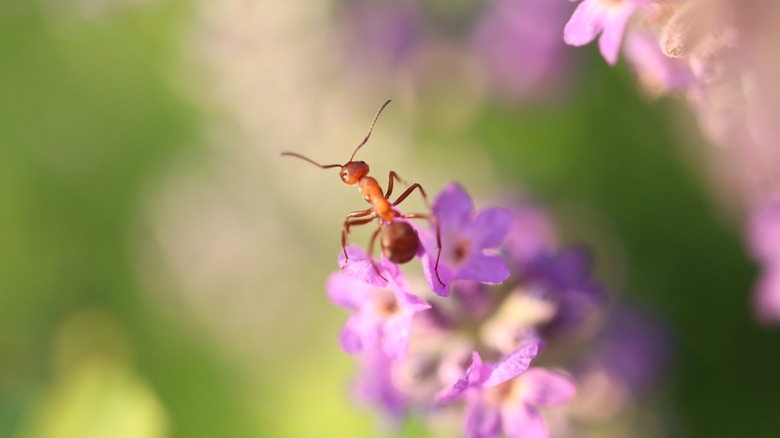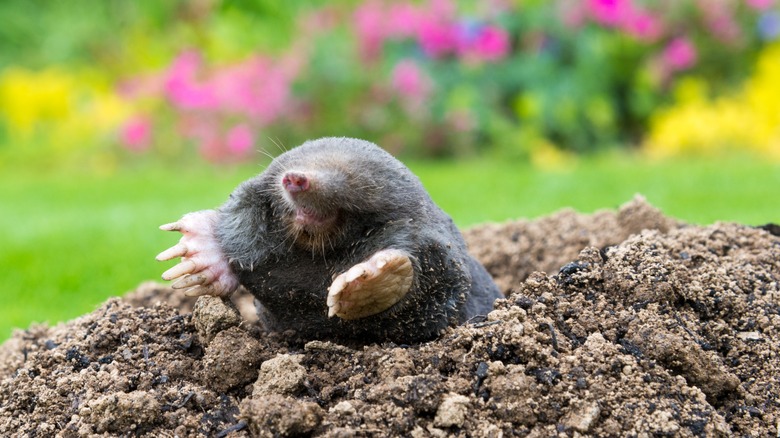Common Pests That'll Come After Your Lavender And How To Stop Them
Like all plants, lavender is not immune from pests — fire ants, spittlebugs, and whiteflies are just a few well-known ones. This might come as a surprise since lavender is often celebrated for its dual ability to attract pollinators and repel many pests, owing much of its protective power to its potent essential oils. The aromatic stronghold of lavender against insect adversaries largely comes from a compound named linalool, which is responsible for lavender's signature scent. However, while these oils make lavender less appealing to a broad spectrum of garden pests, some can navigate or tolerate the plant's defenses, each causing distinct forms of damage. Beyond insects, moles and voles present a challenge, not always drawn by the lavender itself but by the conducive environment your garden offers. Their tunneling and feeding habits can disrupt the root systems and overall health of your lavender plants.
In the battle against these persistent pests, knowledge is your first line of defense. Recognizing what draws them to your lavender plants and the specific harm they can inflict will help you craft effective countermeasures. This might involve adjusting garden conditions to make the environment less hospitable.
Fire ants, spittlebugs, and whiteflies: a closer look
As mentioned, lavender attracts a variety of insects. Starting off with fire ants; they are recognizable by their copper-brown color and aggressive behavior. They can severely damage roots and stress your plants, diminishing their vitality and bloom potential. To fend off fire ants, use an insecticide on the infested area of your plant. However, be sure to read the instructions carefully to prevent any damage to your plant. Alternatively, you can opt for diatomaceous earth as a natural fix. Spittlebugs are another adversary, albeit less common. These pests cloak themselves in a frothy spit-like mass on plant stems, a tell-tale sign of their presence. They're small and green, blending in with the plant life, and feed on the sap, draining the strength from your plant. Hand-picking them is one option. However, a vigorous rinse with water or the application of insecticidal soap can wash away spittlebugs without harming your plants.
Whiteflies present a subtler challenge with their tiny, winged bodies and appetite for the underside of lavender leaves. These pests can lead to yellowing, wilting, and even disease. They're particularly troublesome in warmer climates, where they reproduce rapidly. Introducing predators like ladybugs, which naturally prey on whiteflies, can offer a biological solution to this problem. For more severe cases, treating the affected areas with insecticidal soap or horticultural oils can provide the necessary relief, targeting the pests without damaging your lavender. All in all, each of these pests requires a keen eye and timely intervention to manage.
Moles and voles: the underground threats
Moles and voles, easily mistaken for each other, bring distinct challenges to your garden. Moles, attracted to soil brimming with organic matter and insects, are known to carve out tunnels. These tunnels, while not intended to harm your plants directly, can disrupt the stability and nutrient uptake of your lavender, affecting its health and bloom. On the flip side, voles have a direct impact; they're attracted to your garden for the plants themselves, including your lavender, feeding on roots, which can cause direct and significant damage.
First off, when getting rid of moles, eliminating their food sources is a crucial step. This means maintaining a clean garden free from excess mulch where insects might thrive and attract mole and removing dead plants that could provide cover or food for voles. When it comes to traps, precision is your ally. For moles, find their active tunnels — marked by mounds of soil — and set scissor or pincher traps right in their path. Voles require a different tactic; place mouse traps baited with peanut butter along their visible pathways or near the entrance to their burrows, concealed by a bit of vegetation to hide them from curious pets or children. Building a fence around your lavender garden can provide a physical barrier against both animals. Dig down at least 2 feet and install a wire mesh fence, ensuring it extends a few inches above the ground as well, to prevent voles from climbing over or burrowing under to get to your plants.


